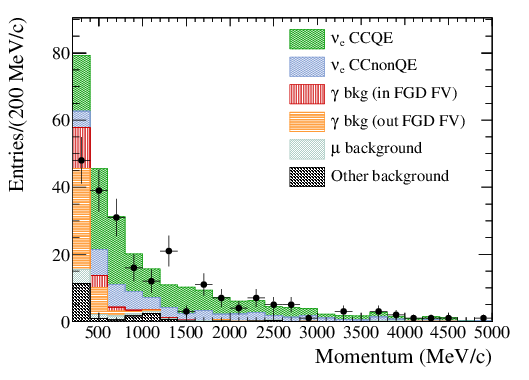Measurement of the intrinsic electron neutrino component in the T2K neutrino beam with the ND280 detector

The main and irreducible background to the appearance signal comes from the presence in the neutrino beam of a small intrinsic component of electron neutrinos originating from muon and kaon decays. In T2K, this component is expected to represent 1.2% of the total neutrino flux. A measurement of this component using the near detector (ND280), located 280 m from the target, is presented. The charged current interactions of electron neutrinos are selected by combining the particle identification capabilities of both the time projection chambers and electromagnetic calorimeters of ND280. The measured ratio between the observed electron neutrino beam component and the prediction is 1.01±0.10 providing a direct confirmation of the neutrino fluxes and neutrino cross section modeling used for T2K neutrino oscillation analyses. Electron neutrinos coming from muons and kaons decay are also separately measured, resulting in a ratio with respect to the prediction of 0.68±0.30 and 1.10±0.14, respectively.
The T2K Neutrino Flux Prediction
The flux prediction is an essential part of the successful prediction of neutrino interaction rates at the T2K detectors and is an important input to T2K neutrino oscillation and cross section measurements. A FLUKA and GEANT3 based simulation models the physical processes involved in the neutrino production, from the interaction of primary beam protons in the T2K target, to the decay of hadrons and muons that produce neutrinos. The simulation uses proton beam monitor measurements as inputs. The modeling of hadronic interactions is re-weighted using thin target hadron production data, including recent charged pion and kaon measurements from the NA61/SHINE experiment. For the first T2K analyses the uncertainties on the flux prediction are evaluated to be below 15% near the flux peak. The uncertainty on the ratio of the flux predictions at the far and near detectors is less than 2% near the flux peak.


